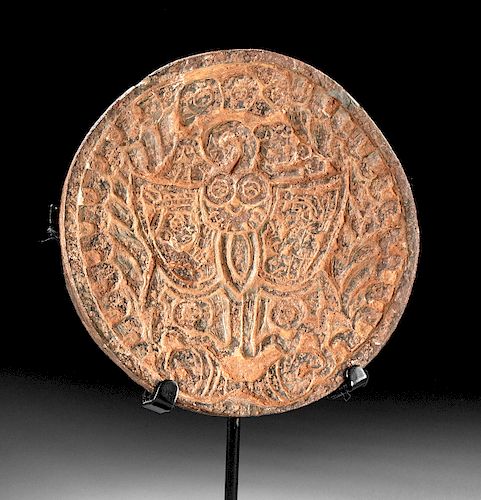Teotihuacan Stone & Magnetite Butterfly Mirror
Lot 4a
About Seller
Artemis Fine Arts
686 S Taylor Ave, Ste 106
Louisville, CO 80027
United States
Selling antiquities, ancient and ethnographic art online since 1993, Artemis Gallery specializes in Classical Antiquities (Egyptian, Greek, Roman, Near Eastern), Asian, Pre-Columbian, African / Tribal / Oceanographic art. Our extensive inventory includes pottery, stone, metal, wood, glass and textil...Read more
Estimate:
$9,000 - $13,000
Absentee vs Live bid
Two ways to bid:
- Leave a max absentee bid and the platform will bid on your behalf up to your maximum bid during the live auction.
- Bid live during the auction and your bids will be submitted real-time to the auctioneer.
Bid Increments
| Price | Bid Increment |
|---|---|
| $0 | $25 |
| $300 | $50 |
| $1,000 | $100 |
| $2,000 | $250 |
| $5,000 | $500 |
| $10,000 | $1,000 |
| $20,000 | $2,500 |
| $50,000 | $5,000 |
| $100,000 | $10,000 |
| $200,000 | $20,000 |
About Auction
By Artemis Fine Arts
Oct 3, 2019
Set Reminder
2019-10-03 10:00:00
2019-10-03 10:00:00
America/New_York
Bidsquare
Bidsquare : Exceptional Day 2: Pre-Columbian & Tribal Art
https://www.bidsquare.com/auctions/artemis-gallery/exceptional-day-2-pre-columbian-tribal-art-4453
Day 2 of an important 2-day auction featuring exceptional, museum-worthy examples of Pre-Columbian from the ancient Americas, Native American, African / Tribal, Oceanic, Spanish Colonial and fossils. Artemis Fine Arts info@artemisfinearts.com
Day 2 of an important 2-day auction featuring exceptional, museum-worthy examples of Pre-Columbian from the ancient Americas, Native American, African / Tribal, Oceanic, Spanish Colonial and fossils. Artemis Fine Arts info@artemisfinearts.com
- Lot Description
Pre-Columbian, Valley of Mexico, Teotihuacan, ca. 150 to 650 CE. An incredible rare artifact, a mirror with a highly polished black magnetite surface on one side and a dark red-brown stone obverse decorated with a relief motif of a butterfly. It is encircled by the characteristic plumed motif around its edges that is common in Teotihuacan art. Here it may have a dual meaning as both feather and wave-like motifs, symbolizing the Mesoamerican underworld, which was reached via water. The butterfly, meanwhile, is linked to the sun and also symbolizes the soul as it flutters on its journey to that underworld and the afterlife - a conception that we believe people at Teotihuacan had based on the later beliefs of the Aztecs, who derived much of their art and religion from the ancient city. Size: 4.25" W x 0.5" H (10.8 cm x 1.3 cm); 7.05" H (17.9 cm) on included custom stand.
Interestingly, two human figures crouch inside the outstretched wings of the butterfly, each turned towards its thick thorax, kneeling and with their hands raised, as if in supplication. The magnetite panels on the back of the mirror are lightly sunk into the fired clay surface. Looking at the shiny black material, it is clear that no one could have really seen their face reflected in it - so what was the purpose of this "mirror"? Like mirrors throughout the ancient world - for example, in Rome and China - this one seems to have served a spiritual purpose, utilized for looking into a world beyond our current one. The multiple panels placed together may have provided different viewpoints.
Mirrors are particularly well represented in the iconography of Teotihuacan compared to other Mesoamerican cultures. Artwork of people there often includes mirrors as personal ornament - in the small of the back, on the chest, or on the headdress. Women, men, and gods all wear them. A monumental sculpture at the Temple of Quetzalcoatl shows a feathered serpent passing through the plumed rim of a mirror, as if using it as a portal from the world of the gods into ours. Mirrors seem to have had complex iconographic meanings that allowed people to mentally visit a world beyond our own.
The piece is accompanied by a short paper written by Peter T. Furst, PhD, describing its iconography in more depth.
Provenance: private Hawaii, USA collection; ex-Ian Arundel collection, Old Curiosity Cabinet, Melrose Ave., Los Angeles, California, USA, collected 1960-70; This piece is accompanied by a paper written by Peter T. Furst, PhD, describing its iconography in more depth.
All items legal to buy/sell under U.S. Statute covering cultural patrimony Code 2600, CHAPTER 14, and are guaranteed to be as described or your money back.
A Certificate of Authenticity will accompany all winning bids.
We ship worldwide and handle all shipping in-house for your convenience.
#148458Magnetite backing looks repaired but is actually constructed that way. The front of the mirror is in great condition with light surface wear commensurate with age, rich deposits in the lower profile areas, and the motifs excellently preserved. Small chips from peripheries.Condition
- Shipping Info
-
All shipping is handled in-house for your convenience. Your invoice from Artemis Gallery will include shipping calculation instructions. If in doubt, please inquire BEFORE bidding for estimated shipping costs for individual items.
-
- Buyer's Premium



 EUR
EUR CAD
CAD AUD
AUD GBP
GBP MXN
MXN HKD
HKD CNY
CNY MYR
MYR SEK
SEK SGD
SGD CHF
CHF THB
THB















